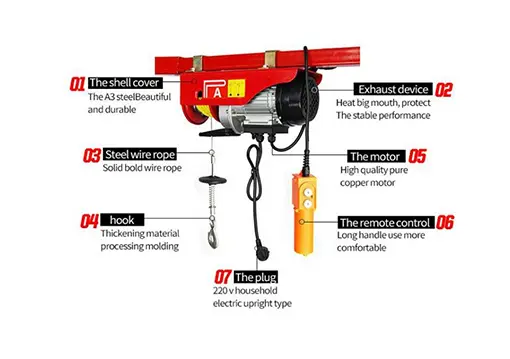


The Advantages and Applications of Wireless Electric Hoists
In the modern industrial landscape, efficiency and safety are paramount. One of the innovations that have greatly contributed to these aspects is the wireless electric hoist. Combining the power of electricity with the freedom of wireless technology, these hoists provide a wide range of benefits that are revolutionizing material handling across various sectors.
What is a Wireless Electric Hoist?
A wireless electric hoist is a device used to lift and lower heavy loads without the physical constraints and hazards associated with traditional hoists. Unlike conventional electric hoists, which require a wired connection and often limit the operator's movement, wireless hoists can be controlled via remote control. This wireless functionality allows users to operate the hoist from a safe distance, thus enhancing safety and efficiency in lifting operations.
Key Advantages
1. Enhanced Safety One of the most significant advantages of wireless electric hoists is the improved safety for operators and bystanders. The ability to control lifting operations remotely means that operators can maintain a safe distance from the load, reducing the risk of accidents in busy work environments. This feature is particularly beneficial in construction sites, warehouses, and manufacturing plants where heavy equipment is frequently in use.
2. Increased Efficiency Wireless hoists allow for quicker setup and operation. With no cumbersome wires to manage, operators can position the hoist in various locations without the worry of entanglement or electrical hazards. This flexibility can lead to increased productivity and less downtime, as workers can easily adapt to changing job requirements.

3. Versatility Wireless electric hoists come in a variety of sizes and configurations, making them suitable for a range of applications. Whether lifting heavy machinery in a factory or moving materials on a construction site, these hoists can handle the demands of diverse tasks. Additionally, they can be adapted for both indoor and outdoor use, making them a versatile choice for many industries.
4. User-Friendly Operation Most wireless electric hoists are designed with user convenience in mind. The remote controls are typically intuitive, allowing even less experienced operators to lift and lower loads effectively and safely. Many models even include features such as emergency stop functions, overload protection, and programmable lifting speeds to further enhance safety and ease of use.
Applications Across Industries
Wireless electric hoists find applications across various sectors. In construction, they are often used to lift heavy materials such as beams, concrete blocks, and equipment. In manufacturing, they streamline processes by facilitating the movement of machinery and components along assembly lines. Warehousing and logistics also benefit from wireless hoists, as they simplify the loading and unloading of goods from trucks and storage shelves.
Moreover, the entertainment industry has embraced wireless electric hoists for stage rigging, allowing for dynamic movement of sets and equipment while ensuring the safety of performers and crew members. Similarly, in shipping and ports, these hoists are crucial for handling containers and heavy cargo.
Conclusion
The shift toward wireless electric hoists marks a significant advancement in the field of material handling. By combining safety, efficiency, and versatility, these innovative devices are transforming how industries operate. As technology continues to evolve, one can only anticipate further enhancements in wireless hoist systems, leading to even greater benefits in the workplace. Ultimately, wireless electric hoists are not just tools; they are essential components that support productivity and safety in a fast-paced world.



